Mantle (MNT) has achieved a strategic transformation from a general L2 to Bybit's core utility token, creating structural demand through integration with the exchange.
Author: @cptn3mox, VC | Markets @hashed_official

Key Points Summary:
Mantle (MNT) has strategically transformed from a general L2 to Bybit's core utility token, creating structural demand through integration with the exchange.
Key catalysts for Bybit integration include enhanced collateral usage, VIP fee tiers, and potential buyback and burn mechanisms, most of which will be launched by the end of September 2025.
Currently, MNT is priced at $1.15, significantly undervalued compared to competitors, with its MCAP/Vol (0.12) and MCAP/OI (0.15) being the lowest compared to major exchange tokens.
Price targets based on competitor benchmarks indicate a potential 3 to 6 times increase within a 6 to 12 month timeframe ($3.45 ~ $6.90).
The emerging but rapidly growing L2 ecosystem of Mantle provides additional utility for deep integration with Bybit, offering security for long-term investments.
Background Introduction
Mantle (MNT) was approved through governance in May 2023, with a 1:1 migration of MNT tokens from BitDAO, and launched its modular Ethereum L2 mainnet in July 2023.
As the network's gas, governance, and incentive token, MNT is the core vehicle driving most activities and governance within the network. The L2 network Mantle is primarily supported by the Mantle treasury, which has $4 billion in assets, along with a $200 million ecosystem fund to support RWA and DeFi development within the ecosystem.
In July 2025, Mantle decided to deeply integrate with Bybit, positioning MNT as its core utility token for fee discounts and collateral usage (similar to Binance's BNB), along with other potential catalysts.
This was further strengthened in August 2025, when Mantle appointed Bybit's co-CEO (Helen Liu) and Bybit's head of spot trading (Emily Bao) as key advisors to collaborate with Mantle's core team.
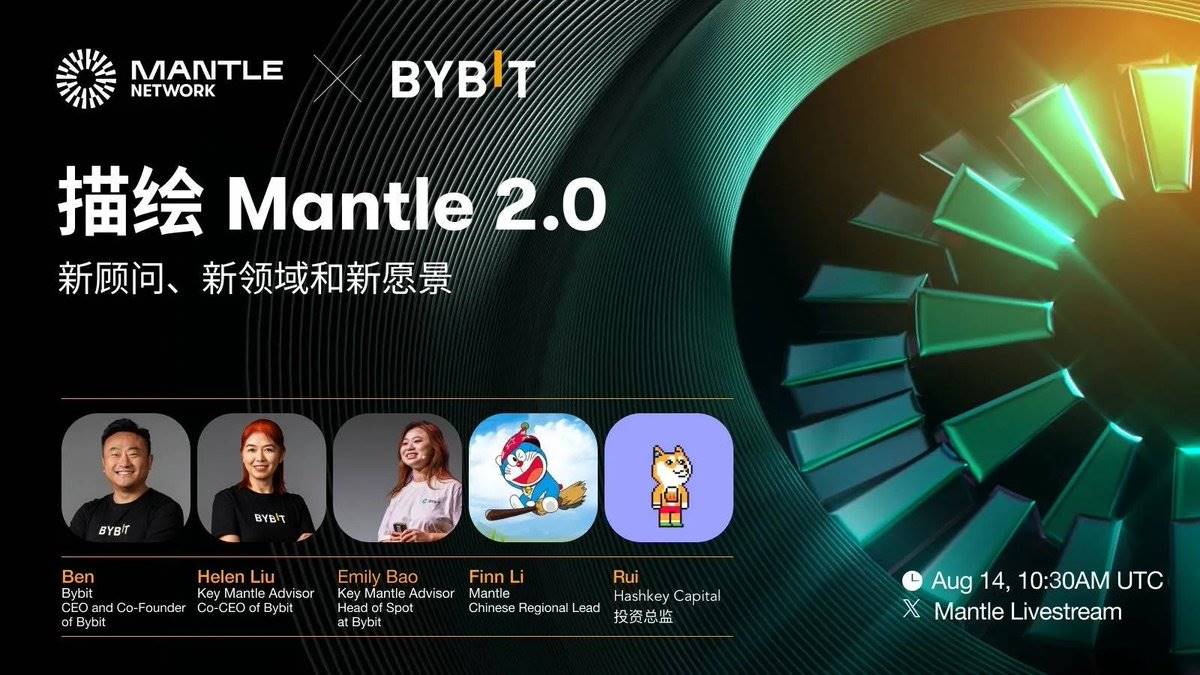
Catalysts: Why Now?
MNT, as Bybit's core utility token, is expected to achieve significant growth. Here are some announced catalysts, while others are implied or still speculative.
Bybit Integration Roadmap
Collateral Usage: Traders can use MNT as collateral for perpetual contract trading (link)
Launched, but the collateral value ratio has recently increased significantly.
For example: If you previously held 1 million MNT tokens, you could trade with a maximum of 90% LTV, now you can trade with 100% LTV;
If you are a large institution holding 8 million MNT tokens, you could previously trade with only 10% LTV, now you can trade with 60% LTV.
VIP Fee Tiers: Hold MNT for trading discounts (link)
Spot trading enjoys a 25% discount.
Linear contracts (USDT perpetual contracts/futures, USDC perpetual contracts) enjoy a 10% discount.
This naturally creates structural buying demand, especially from institutional traders who must save on trading fees.
Potential Buyback and Burn: Utilizing CEX revenue for buybacks and burns
If approved, this could be the largest catalyst for MNT.
Must go through governance proposals and gain approval from token holders (but we know the supply is concentrated among shareholders).
Reduces circulating supply and could potentially make MNT deflationary (see AMA recap).
OKX / OKB example (link).
OTC Portal: Enabling large buyers to purchase MNT in bulk (current liquidity is scarce)
In development, targeting whales/funds.
The web version will be launched by the end of September, allowing for self-directed bulk OTC/RFQ trading.
Other MNT Utilities:
MNT Launchpool: Stake MNT to receive tokens from the Launchpool at Bybit TGE.
Increase in spot trading pairs: Available spot trading pairs will expand from 4 to over 20, planned to start in September 2025.
Crypto card usage: By the end of September, MNT can be used for crypto card payments, with zero conversion fees, and consumer-level users will receive additional acceleration for faster VIP upgrades and more cashback through Bybit Card & Pay.
Bonus: In addition to ongoing activities like the MNT Puzzle Hunt, we also plan to offer options trading and access to VIP events and merchandise.
Timeline
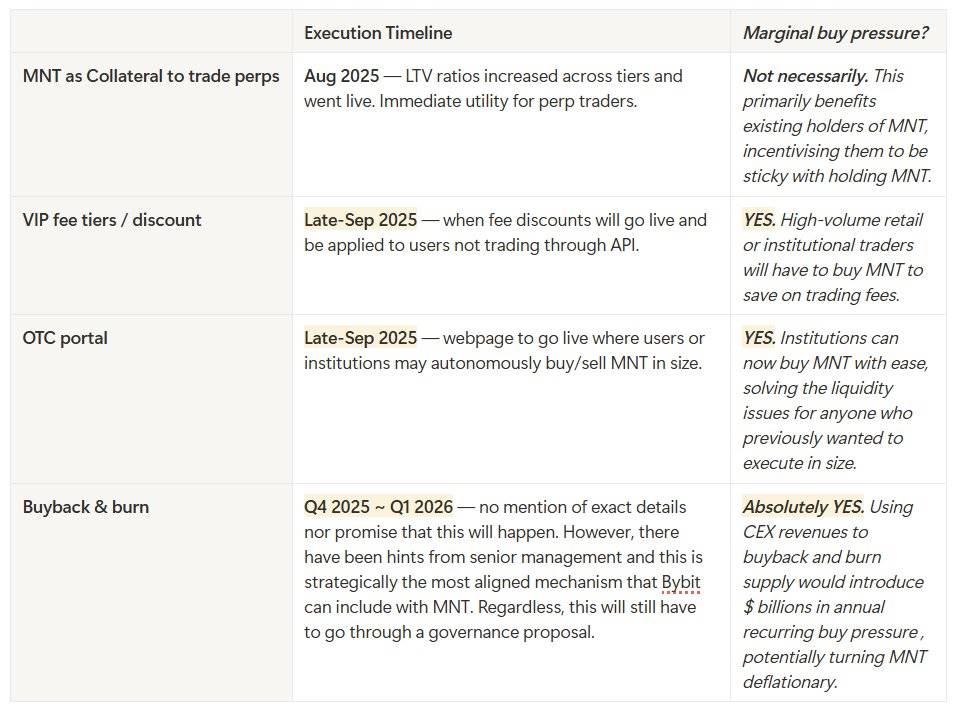
Comparison with Other Exchanges
MNT Reference Price = $1.15
MNT is the most undervalued exchange token in terms of "MCAP/Vol" and "MCAP/OI" metrics.
Bybit's trading volume is 1/3 of Binance, but MNT's market cap is only 1/30 of BNB.
Bybit's trading volume is 5 times that of Crypto(dot)com, but MNT's market cap is only half of CRO.
Bybit's trading volume is 2 times that of Hyperliquid, but MNT's market cap is only 1/3 of HYPE.
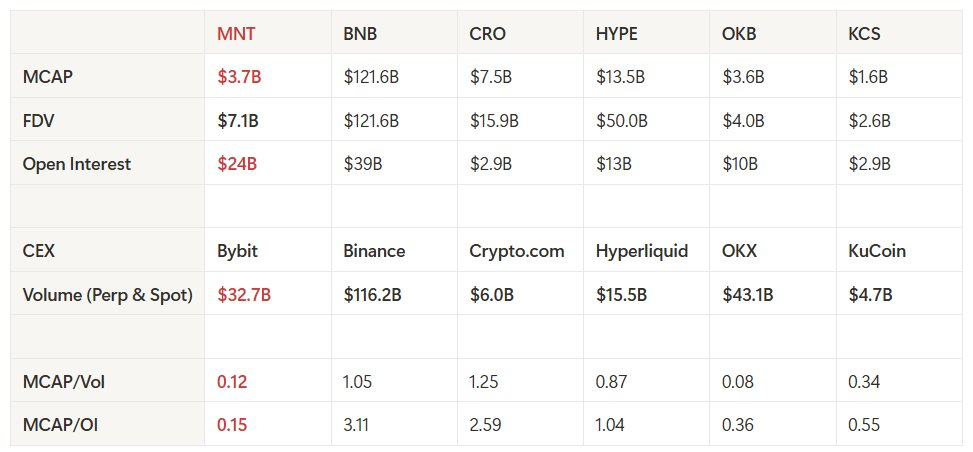
Price Targets
Current MNT Price: $1.15 / Market Cap: $3.7 billion
1. Using MCAP/Vol Metric
Assuming the same MCAP/Volume as Binance (1.05): $1.15 → $10.10 (approximately 8.7 times return on investment).
Assuming the average MCAP/Volume of competitors (approximately 0.71): $1.15 → $6.88 (approximately 6 times return on investment).
2. Quantified Flows (based solely on the impact of buybacks and burns)
Assumptions
Daily trading volume: approximately $32.7 billion (85% perpetual contracts + 15% spot).
Fee structure (broad assumptions): perpetual contracts approximately 0.02% fee + spot approximately 0.1%.
Potential Annual Revenue:
Perpetual contracts: 85% × $32.7 billion × 0.02% × 365 ≈ $2.03 billion in perpetual contract fee revenue.
Spot: 15% × $32.7 billion × 0.1% × 365 ≈ $1.8 billion in spot fee revenue.
Total: perpetual contracts + spot = $3.8 billion in total fee revenue.
If governance allocates 20% of CEX revenue to MNT buybacks and burns:
Approximately $760 million in buybacks annually.
At a token price of $1.15, this equates to purchasing approximately 660 million MNT tokens per year (about 20% of circulating supply).
Impact: This flow would significantly reduce effective float and could drive price appreciation similar to BNB/OKB.

3. On-chain TVL Metrics
Assuming the same MCAP / bridging TVL as BNB Chain (5.1x): $1.15 → $2.68 (approximately 2.3 times return on investment).
Assuming the same MCAP / stablecoin as BNB Chain (10.5x): $1.15 → $1.54 (approximately 1.4 times return on investment).
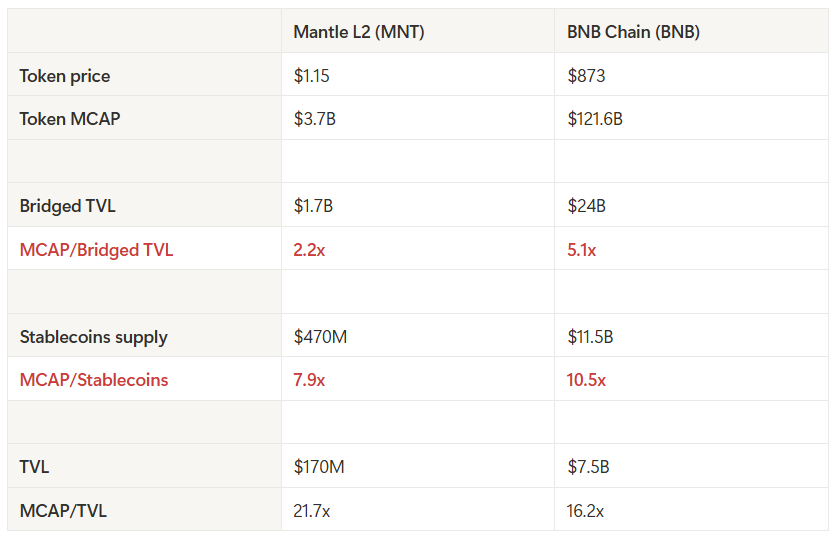
4. Continuing the Scenario: Bybit Grows to the Same Scale as Binance, MNT's Market Cap Equals BNB's Market Cap
- There is a 30x upside from here.
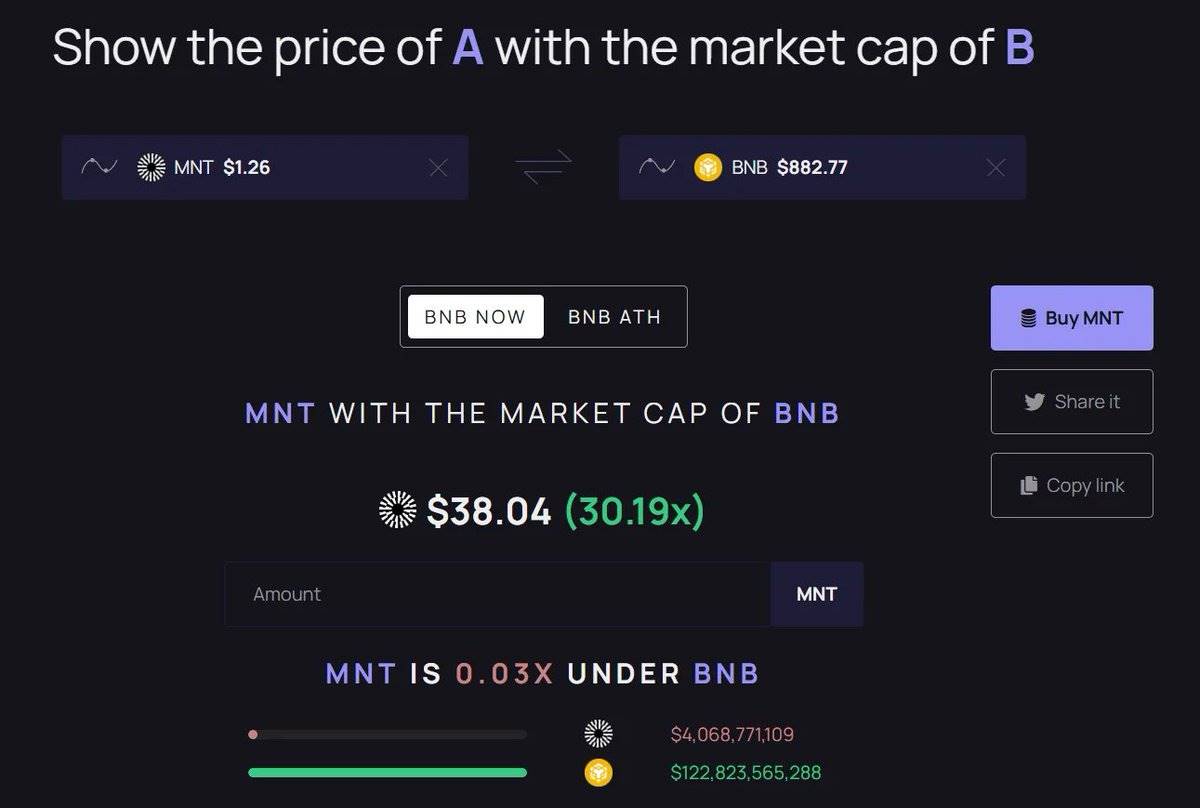
Summary
Multiple valuation methods highlight the significant undervaluation of MNT relative to its peers.
Comparing with BNB's MCAP / trading volume data implies a potential price target for MNT of $10.10, representing approximately 8.7 times appreciation as Bybit and MNT integration matures.
Among exchange competitors, comparing with the average MCAP / trading volume data implies a potential price target for MNT of $6.88, indicating approximately 6 times growth potential.
Based on other individual valuation metrics, MNT is expected to achieve 2 to 3 times growth.
If all these catalysts come into play within the next year, MNT could reach a target price of $3.45 to $6.90.

Risks
Execution Risk: The buyback and burn proposal has not yet been approved. Without this, MNT remains merely a collateral/fee token.
Dependence on Bybit: This theory largely relies on Bybit's adoption catalysts. If trading volume stagnates or Bybit loses market share in competition with other centralized exchanges, MNT's upside will be limited.
Ecosystem Stickiness: Although Mantle L2 has $170 million in TVL, it is still small compared to BNB's $7.5 billion, requiring stronger on-chain product adoption to support the theory of exchange tokens.
Competition: Other L2s (Base, Arbitrum) and exchanges (BNB, OKB, HYPE) may surpass Bybit in innovation, reducing market attention on Bybit and marginal buyers for MNT.
Invalid Signals
Fundamentals
MNT buyback and burn proposal fails to pass.
Bybit reduces emphasis on MNT integration or signals a slowdown in MNT promotion.
Allocation for buybacks is less than initially expected, or buybacks stall once initiated.
Significant dilution from the treasury increases circulating supply.
Any broader macro risk aversion increases supply pressure.
Price
If the price falls below $0.82, a cut is needed.
This is a critical level that would bring MNT back to the state before all Bybit announcements and is a resistance level that MNT will struggle to break through during 2025.
Indicates that the market does not care about or undervalues the deep integration between Bybit and MNT.
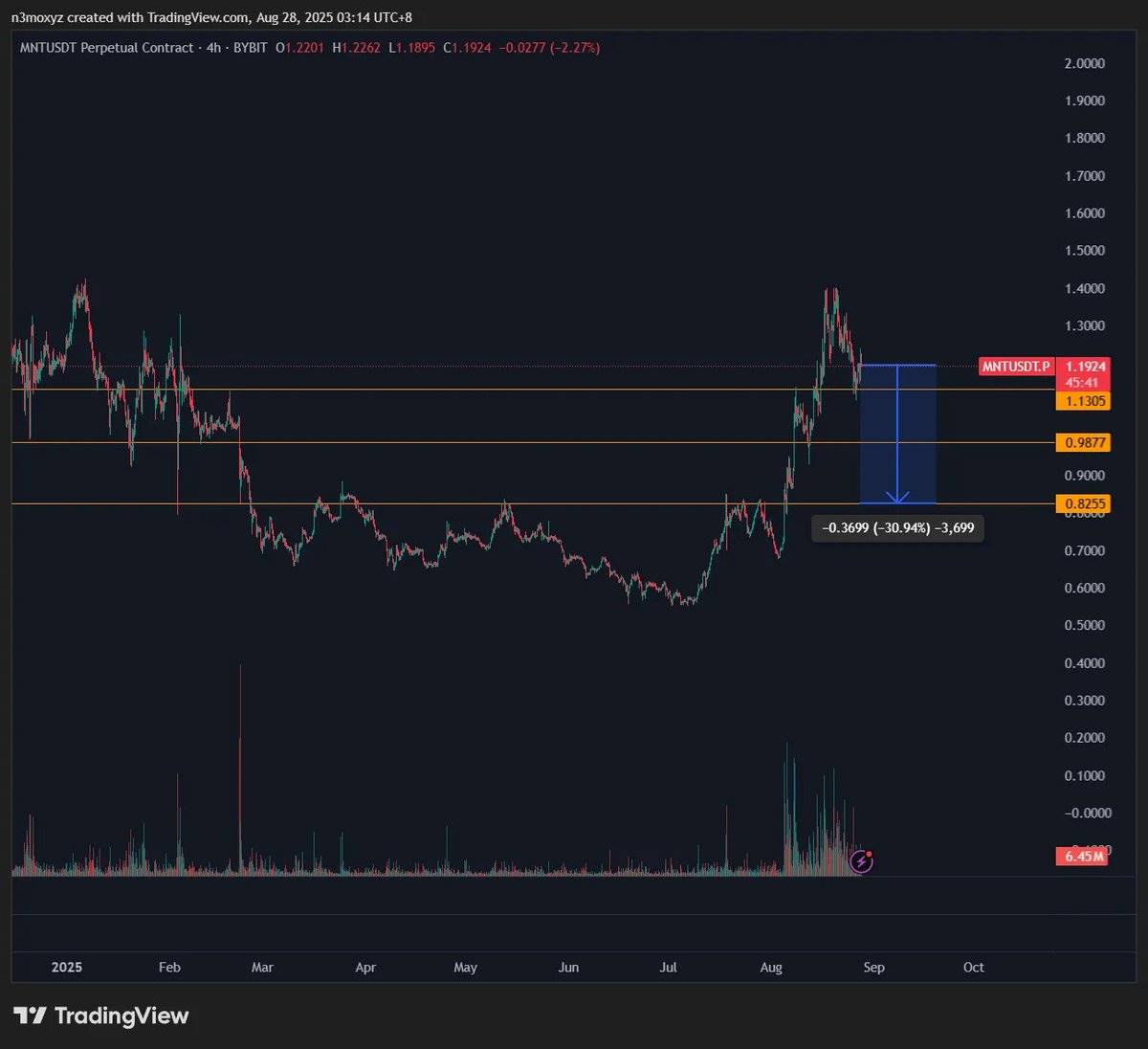
Conclusion
Mantle (MNT) is at a critical turning point in its token journey, seamlessly upgrading from its past L2 token functionality to Bybit's core utility token. Factors such as increased collateral rates, upcoming Q4 MNT fee discounts, the soon-to-launch OTC platform, and potential buybacks and burns signal significant structural demand and potential deflationary mechanisms.
Despite the risks of execution delays, dependence on Bybit, and L2 competition, MNT's valuation metrics are clearly lagging behind peers like BNB, OKB, CRO, and HYPE.
With no upcoming token unlocks and the CeDeFi flywheel starting, MNT is an undervalued gem, expected to rise 3 to 6 times in the next 6 to 12 months.
Disclaimer: The content of this article is for reference only and should not be considered legal, business, investment, or tax advice. Hashed currently holds or plans to invest in the assets mentioned above. The information provided here does not contain any material non-public information.
免责声明:本文章仅代表作者个人观点,不代表本平台的立场和观点。本文章仅供信息分享,不构成对任何人的任何投资建议。用户与作者之间的任何争议,与本平台无关。如网页中刊载的文章或图片涉及侵权,请提供相关的权利证明和身份证明发送邮件到support@aicoin.com,本平台相关工作人员将会进行核查。




